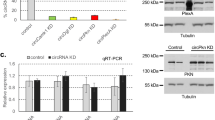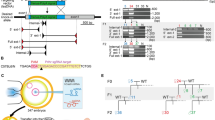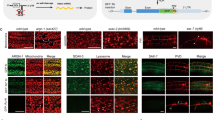Abstract
In the postgenomic era the elucidation of the physiological function of genes has become the rate-limiting step in the quest to understand the development and function of living organisms. Gene functions cannot be determined by high-throughput methods but require analysis in the context of the entire organism. This is particularly true in the developing vertebrate nervous system1. Because of its easy accessibility in the egg, the chicken embryo has been the model of choice for developmental in vivo studies. However, its usefulness has been hampered by a lack of methods for genetic manipulation. Here we describe an approach that could compensate for this disadvantage. By combining gene silencing by dsRNA2 (through RNA interference, RNAi) with in ovo electroporation3,4, we developed an efficient method to induce loss of gene function in vivo during the development of the chicken CNS. This method opens new possibilities for studying gene function not only by gain-of-function but also by loss-of-function approaches and therefore represents a new tool for functional genomics.
This is a preview of subscription content, access via your institution
Access options
Subscribe to this journal
Receive 12 print issues and online access
$209.00 per year
only $17.42 per issue
Buy this article
- Purchase on SpringerLink
- Instant access to full article PDF
Prices may be subject to local taxes which are calculated during checkout



Similar content being viewed by others
Accession codes
References
Lo, D.C. Challenges for neuroscience in a post-genome world. Nat. Neurosci. 4, 1153–1154 (2001).
Fire, A. et al. Potent and specific genetic interference by double-stranded RNA in Caenorhabditis elegans. Nature 391, 806–811 (1998).
Muramatsu, T., Mizutani, Y., Ohmori, Y. & Okumura, J. Comparison of three nonviral transfection methods for foreign gene expression in early chicken embryos in ovo. Biochem. Biophys. Res. Commun. 230, 376–380 (1997).
Itasaki, N., Bel-Vialar, S. & Krumlauf, R. 'Shocking' developments in chick embryology: electroporation and in ovo gene expression. Nat. Cell Biol. 1, E203–E207 (1999).
Müller, U. Ten years of gene targeting: targeted mouse mutants, from vector design to phenotype analysis. Mech. Dev. 82, 3–21 (1999).
Tang, J., Rutishauser, U. & Landmesser, L. Polysialic acid regulates growth cone behavior during sorting of motor axons in the plexus region. Neuron 13, 405–414 (1994).
Stoeckli, E.T. & Landmesser, L.T. Axonin-1, NrCAM, and NgCAM play different roles in the in vivo guidance of chick commissural neurons. Neuron 14, 1165–1179 (1995).
Burstyn-Cohen, T. et al. F-spondin is required for accurate pathfinding of commissural axons at the floor plate. Neuron 23, 233–246 (1999).
Perrin, F.E., Rathjen, F.G. & Stoeckli, E.T. Distinct subpopulations of sensory afferents require F11 or axonin-1 for growth to their target layers within the spinal cord of the chick. Neuron 30, 707–723 (2001).
Momose, T. et al. Efficient targeting of gene expression in chick embryos by microelectroporation. Dev. Growth Differ. 41, 335–344 (1999).
Swartz, M., Eberhart, J., Mastick, G.S. & Krull, C.E. Sparking new frontiers: using in vivo electroporation for genetic manipulations. Dev. Biol. 233, 13–21 (2001).
Li, Y.-X., Farrell, M.J., Liu, R., Mohanty, N. & Kirby, M.L. Double-stranded RNA injection produces null phenotypes in zebrafish. Dev. Biol. 217, 394–405 (2000).
Wianny, F. & Zernicka-Goetz, M. Specific interference with gene function by double-stranded RNA in early mouse development. Nat. Cell Biol. 2, 70–75 (2000).
Zhao, Z., Cao, Y., Li, M. & Meng, A. Double-stranded RNA injection produces nonspecific defects in zebrafish. Dev. Biol. 229, 215–223 (2001).
Stoeckli, E.T. & Landmesser, L.T. Axon guidance at choice points. Curr. Opin. Neurobiol. 8, 73–79 (1998).
Ikonomov, O.C., Kulesa, M.C., Shisheva, A.C. & Jacob, M.H. Innervation and target tissue interactions induce Rab-GDP dissociation inhibitor (GDI) expression during peripheral synapse formation in developing chick ciliary ganglion neurons in situ. J. Neurosci. 18, 6331–6339 (1998).
Stenmark, H. & Olkkonen, V.M. The Rab GTPase family. Genome Biol. 2, Reviews 3007.1–3007.7 (2001).
Geyer, M. & Wittinghofer, A. GEFs, GAPs, GDIs and effectors: taking a closer (3D) look at the regulation of Ras-related GTP-binding proteins. Curr. Opin. Struct. Biol. 7, 786–792 (1997).
Perrin, F.E. & Stoeckli E.T. Use of lipophilic dyes in studies of axonal pathfinding in vivo. Microsc. Res. Tech. 48, 25–31 (2000).
Acknowledgements
We thank Monika Mielich for excellent technical assistance. This work was carried out at the University of Basel, Institute of Zoology, and was supported by the Swiss National Science Foundation, the Ott Foundation, and the Human Frontier Science Program Organization.
Author information
Authors and Affiliations
Corresponding author
Ethics declarations
Competing interests
The authors declare no competing financial interests.
Rights and permissions
About this article
Cite this article
Pekarik, V., Bourikas, D., Miglino, N. et al. Screening for gene function in chicken embryo using RNAi and electroporation. Nat Biotechnol 21, 93–96 (2003). https://doi.org/10.1038/nbt770
Received:
Accepted:
Published:
Issue Date:
DOI: https://doi.org/10.1038/nbt770



